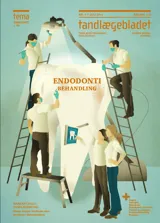Aseptikk og antiseptikk i endodontien
Målet med endodontisk behandling er å forebygge og behandle sykdommen apikal periodontitt. Eliminering av bakterier i rotkanalen er nødvendig for å oppnå en vellykket rotkanalsbehandling.
Rotkanalsprosedyren er basert på biologiske prinsipper om aseptikk og antiseptikk og inkluderer mange faser, som mekanisk utrenskning, irrigasjon og desinfeksjon. Rotfylling og en tett koronal forsegling skal forhindre reinfeksjon av kanalen.
Det er også viktig å forhindre kontaminasjon og infeksjon av rotkanalen under behandling. En vellykket rotkanalsbehandling sikres best ved å bruke kofferdam, sterile borr og instrumenter.
Aseptiske prosedyrer inkluderer også fjerning av plakk, karies og defekte fyllinger. Mangelfull aseptikk og antiseptikk gir infeksjon som kan forklare de mange mislykkede rotkanalsbehandlinger.
Aseptic and antiseptic procedures in endodontic treatment The primary goal in endodontic treatment is to prevent and eliminate apical periodontitis. Elimination of microbial contamination from the root canal system is a prerequisite to the successful outcome of root canal treatment and is based on biological principles of aseptic and antiseptic procedures.
The root canal procedure consists of several phases, which includes mechanical preparation, irrigation and disinfection. To prevent reinfection, a root filling is placed in the instrumented canal with a tight coronal seal.
It is important to prevent contamination and reinfection of the root canal during treatment. Aseptic procedures includes removal of plaque, caries and defective fillings prior to the initiation of treatment. During root canal treatment, proper rubberdam application is indispensable and sterile burs and instruments must be used.
Inappropriate aseptic and antiseptic procedures lead to infection, and might explain the high occurrence of failures in root canal treatments.


